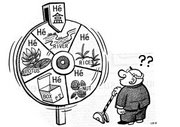Tones
Mandarin Chinese has four pitched tones and a "toneless" tone. The reason for having these tones is probably that the Chinese language has very few possible syllables -- approximately 400 -- while English has about 12,000. For this reason, there may be more homophonic words , words with the same sound expressing different meanings, in Chinese than in most other languages. Apparently tones help the relatively small number of syllables to multiply and thereby alleviate but not completely solve the problem. Learning Chinese in context, therefore, is very important.
For example, the Chinese use only one syllable "da" and yet can tell the difference between "to hang over something" ( da1 ), "to answer" (
da1 ), "to answer" ( da2), "to hit" (
da2), "to hit" ( da3), and "big" (
da3), and "big" ( da4). The answer in the tones.
da4). The answer in the tones.
The numbers after each of the syllables indicates the tone. In normal text this is indicated as  . In the diagram below you can see the tones.
. In the diagram below you can see the tones.
Tone | Mark | Description |
| 1st | | High and level. |
| 2nd | | Starts medium in tone, then rises to the top. |
| 3rd | | Starts low, dips to the bottom, then rises toward the top. |
| 4th | | Starts at the top, then falls sharp and strong to the bottom. |
| Neutral | | Flat, with no emphasis. |
This diagram helps visualize the pitches of the four tones:

The tone of a syllable may change in some situations. For example, these are the characters for "mother"  . As separate characters each is pronounced as "ma," but when put together, the second "ma" becomes toneless:
. As separate characters each is pronounced as "ma," but when put together, the second "ma" becomes toneless:  . Rules like this are, however, very few and very easy to remember.
. Rules like this are, however, very few and very easy to remember.

